Every time we take a photograph, it is necessary to use accurate exposure settings, regardless if we use film or digital cameras. Automatic exposure control has advanced to the point that in most cases we can rely on our camera equipment to come up with the correct camera settings. However, there will be times when this won’t work, when the light meters in our cameras will be fooled. Take a bright, sunlit winter scene, for instance. The snow will reflect a huge amount of light which will fool our built in light meters into registering a larger amount of light than what is actually available. The result will be an underexposed picture with the snow being rather dingy. Not at all what the scene looked like.
In cases like this, many people will set their cameras to automatically overexpose by a stop or two, but that is nothing more than guess work. Ideally, a handheld light meter is the most accurate instrument to determine the correct exposure setting.
Since the advent of the early selenium cell light meters in the 30s, light meters have come a long way. Built-in, automatic exposure control has made exposure settings so effortless that a lot of camera users hardly give it a thought anymore. On the other hand, especially in professional applications, full manual control over exposure settings is often an absolute must. A portrait for instance might call for a white background. Obviously, a white background material, like seamless paper, is the correct choice here. Yet, just because we use a material which we consider white, this does not necessarily turn into a white background in a photograph. As a matter of fact, given the right control, a photograph taken of a subject against a white background can actually result in a photograph which shows a very dark or even black background, just as a black background can be rendered white in a photograph. All that is necessary is a good understanding of exposure and a good hand-held light meter.
Most hand-held light meters are basically designed as incident light meters, yet for full control over our exposure settings a reflective light meter is absolutely necessary also. Let’s look at the differences: A reflective light meter, like all of the light meters built into our cameras, reads the intensity of the light which is reflected off the subject. An incident light meter on the other hand will read the intensity of the light which illuminates the subject. A closer look at both types will reveal their inherent differences.
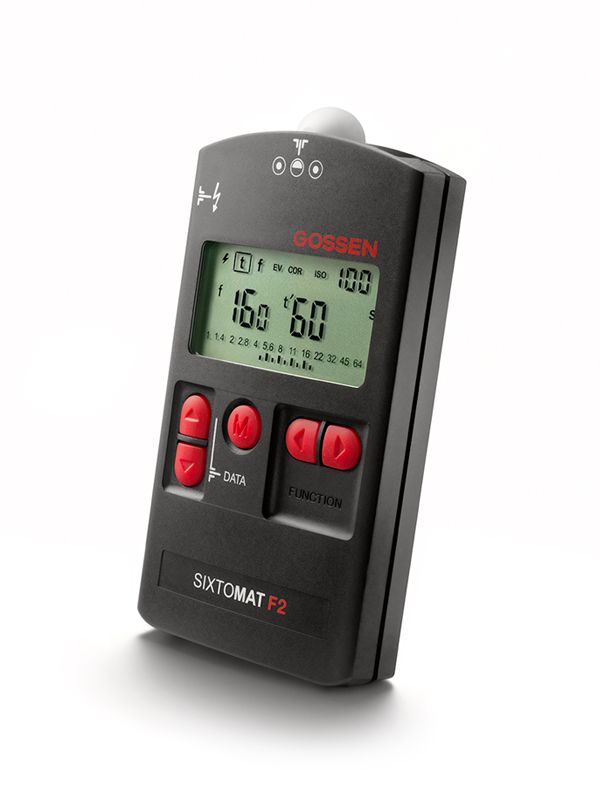
Gossen Sixtomat F2
The meter is in the incident reading position.
To switch to a reflected reading, all that is necessary
is to slide the incident sphere off to the side.
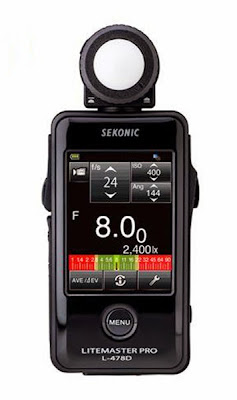
Sekonic L-478D
The meter as shown is for incident readings.
In order to switch to reflective reading,
a separate reflective reading attachment needs
to be purchased. To take a reflected reading,
it is necessary to remove the incident sphere
and replace it with the reflective reading attachment
If we take a reflective light meter and aim it at a subject of average brightness, it will give an accurate reading. For easier understanding, let’s aim the light meter at an area which is painted an average gray. Such a surface will reflect an average amount of the light which illuminates it and the meter will react accordingly, giving a certain exposure setting. Without change in illumination, if the gray area is replaced by a pure white one, what will happen? The white surface obviously will reflect a lot more light which the light meter will register. Replacing that area with a black one will result in just the opposite. Without any change in relative brightness, our meter has now come up with three distinctively different exposure settings.
Reflective light meters are all calibrated to register (or assume) an average level of reflectance, as with the gray surface. Subsequently, the exposure reading obtained from the gray surface is the correct one. The white surface will actually fool the meter into registering a higher light intensity, just as the black one will result in registering a lower light intensity. Both of those exposure settings will be wrong. The end result is actually that the meter will render exposure settings which make all three surfaces in the photograph grey. This is the very reason why photographs of a snow scene will usually be underexposed, while photographs at dusk or at night often come out much lighter than the actual scene.
This is where an incident light meter has tremendous advantages. It only registers the relative brightness of illumination. The resulting exposure settings will make an object of average brightness average in the photograph also. Subsequently, a lighter surface will be lighter in the photograph just as a darker one will show up darker.
So it may seem that for accurate camera settings an incident light meter is the way to go. In most situations this actually is indeed the case. But what about a white background? The exposure setting we choose has to be such that not only the subject is exposed properly, but also the background, which in our example is to be white.
A three stop overexposure will generally result in white, just as a four stop underexposure will result in black. This is easily verified by taking an evenly illuminated white back ground and taking a reflective reading. We then open the lens by three stops and take an exposure. Then subsequent exposures are taken in 1/3 stop increments until a four stop underexposure has been reached. The results will then show the various shades of gray (white and black are also considered shades of gray here) which can be achieved with various degrees of over and under exposure. Please note that these are average settings. Digital sensors vary in their response to over and underexposure. However, a simple test like the one above will easily show the amount of overexposure and underexposure necessary to render white or black without detail.
For example, if for a white background it is necessary to see if it is three stops overexposed, we must do the following:
We determine the correct exposure for the subject with the light meter in the incident mode. This will be very accurate and therefore establish the actual camera settings. These settings also need to overexpose the background by three stops in order to render it white. To check this, all we need to do is switch the meter to the reflective mode. Now the meter will register the amount of light which is actually reflected by the background. If this indeed shows an overexposure of three stops, the background will be white, as would a four or 5 stop overexposure. But that is not advisable at all since otherwise the background will reflect such a strong amount of light that it very likely will result in flare or loss of detail at the edges of the subject. If the reflective reading of the background registers less than a three stop overexposure, it is ultimately a simple interpretation of what the background will look like. A two stop overexposure for instance would render a very light gray background; a one stop overexposure would still render a noticeably lighter grey. The same exposure as the one for the subject would render an average or neutral grey, while underexposure would render progressively darker shades of grey until the background is rendered black.
For example: The basic exposure for the subject is 1/60 sec @ f/5.6. For the background to be three stops over, the meter would have to read 1/60 @ f/16. If we were to expose at f/16, the background would be medium gray, but since the actual camera setting for the subject calls for f/5.6, that is indeed a three stop overexposure compared to f/16. Does it matter if the background material is actually white? No it does not! Regardless of color or brightness, if the background is illuminated such that it registers a three stop overexposure, it will be white. On the other hand, if the overexposure is less than three stops, the background will show various degrees of light grey, red, green or whatever other color the background may be, but with an underexposure of four stops, all will be black.
The above photograph is a good example of predicting the outcome of the photograph with the help of a good, hand-held light meter. The bright light, outlining the profile of the face and the hands was purposely chosen at +2 1/2 (2 1/2 stops over). This was determined with an incident light reading of just the main light source and then opening the lens by 2 1/2 stops. The rest of the face needed to be quite dark, but also needed to show detail. For that an underexposure of -2 1/2 stops was chosen. This again was done with an incident reading by adjusting the intensity of the light source until it registered –2 1/2. This photograph was actually shot in a studio with all white walls and a white floor. No black background material was used. The subject was approximately 30 feet from the background. With that distance, so little light reached the background that the reflective meter did register an underexposure of almost 3 stops. In the original enlargement one can actually see a slight separation between the dark part of the hands and the background which is ever so slightly lighter. This kind of control would not be possible without a good, handheld light meter offering both incident and reflective reading capability, and certainly no automatic metering system, however sophisticated, would allow this to be done.
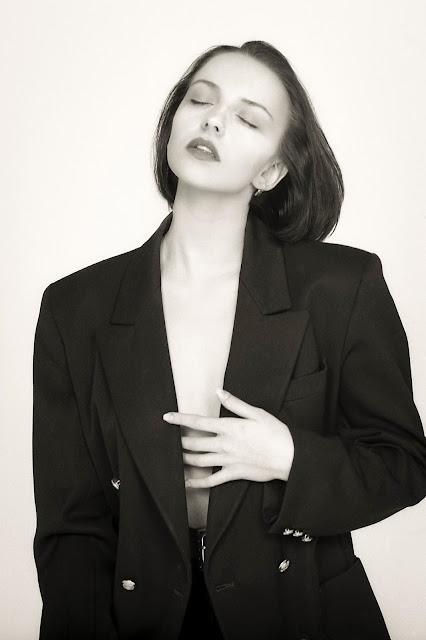

These two examples are much less complicated. Only one soft light source, an umbrella, was chosen to illuminate the subject. For an almost white background, its lighting was set to render an almost three stop overexposure in the first example while a reflective reading of the background rendered a neutral density background in the second photograph.
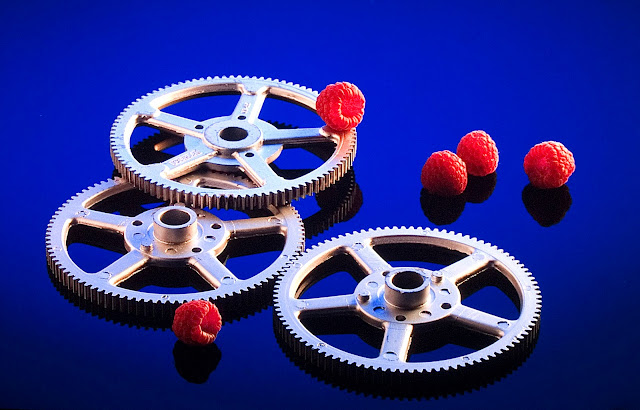
A similar technique was applied for the above color photograph. Via incident reading the correct exposure for the subject and subsequent camera settings were determined. A spot with blue gel was used on the background which was positioned such that it would reflect off a piece of black plexiglass on which the subject was positioned. For the relatively intense blue an overexposure of one stop was chosen. With a reflective reading of the reflection off the plexiglass the background light was adjusted until this exposure was reached.
Could the same background exposure be achieved with an incident reading? Not at all. While an incident reading can determine the relative brightness of the light source, it cannot give any information about how much of that light is actually reflected by the background material. A reflective meter on the other hand will read exactly that. Therefore, to have the total control described above, both incident and reflective meters are essential.
It must also be mentioned here that a lot of light meters require the removal of the incident sphere and replacement with a reflective reading attachment. In situations as described above, those meters have proven to be very cumbersome. Light meters which allow the incident sphere to slide aside and thus changing to a reflective reading have proven to be much more practical.
Could the subject exposure be determined with a reflective meter? Yes, but it is much more difficult. Especially with portraits, we have to deal with a large variety of skin tones. Most Caucasian skin tones are too light and would lead to a slight underexposure with a reflective reading, just as very dark skin tones would lead to overexposure. An incident meter on the other hand will automatically render exposure settings which will render the skin tones accurately, regardless of how bright or dark they might be. An incident meter will render true tonality in both color and black and white.
A good example is the photograph below. A simple, diffused light source (umbrella) was used as the only form of illumination. This, of course, rendered a mostly black photograph. The incident meter, aimed at the light source easily gave the correct camera setting. Most reflective light meters would have failed with the possible exception of a spot meter. Any automatic exposure control would have been fooled by the mostly black scene, including any of the computer controlled matrix metering systems, regardless of manufacturer.
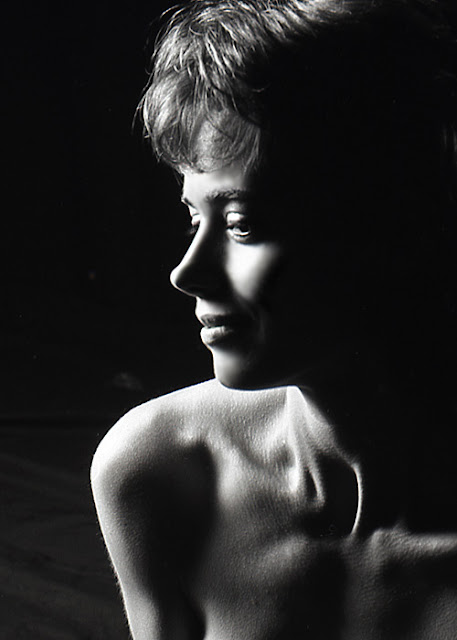
The question is often asked about where to aim the incident meter when multiple light sources are used. That ultimately depends on the approach to lighting. I know that a lot of photographers set up lighting, especially for portraits, by establishing certain lighting ratios, which then are set up with the help of a light meter. I prefer to exercise full visual control. It is my philosophy that no meter “knows” what lighting is right for an individual. Further, I strongly feel that the lighting should be set to accent the individual. Preconceived lighting ratios can’t always do that. Therefore, I set up lighting to best accent the task at hand. Once I decide on a certain lighting, as in the above examples, I start with the main light and then use fill as necessary. With other words, I adjust the lights until they look good. Then, for the reading, I aim the incident meter toward the main light source, may it be a soft box, umbrella, scrim, window or any other. That will give the correct camera settings, and everything else will literally fall into place.
A word of caution about the measuring range of the light meter. Using large format cameras often necessitates very small apertures like f/32 or f/45. To apply the same control as described above to get a true white background would subsequently require a light meter capable of reading apertures of f/90 or f/128. While some light meters are capable of doing this for continuous light, few are able to do the same for electronic flash. The same also applies to maximum exposure time. While very long exposure times usually are not necessary, it is however, a good idea to have ample reserve in this respect in order to be able to handle all photographic situations. The longest exposure time I ever needed to use was one hour.
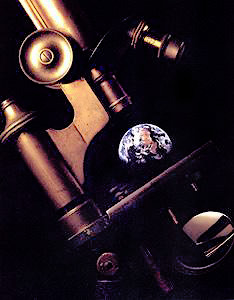
The above photograph is not computer manipulated. It is a double exposure of the microscope and a carefully positioned rear projection screen with the image of the earth projected onto it. The exposure for the microscope, once lighting was set up, was determined with an incident reading and the first exposure was done accordingly with just a black background. After carefully positioning the rear projection screen, a reflective reading of the projected image was taken. An incident reading will not work in this situation since there is no illuminating light source. Instead an actual reading of the true brightness of the projected image had to be taken, which can only be done with a reflective meter. The meter was placed flat against the rear projection screen over the area showing the brown area visible in the center. No adjustments to the reading were necessary because this color of the earth is of neutral density. This reading was then used to expose the background.
A common practice among professional photographers is to use Polaroid film or to use the viewing screen of digital cameras to verify exposure. While there is nothing inherently wrong with that, it is still beneficial to be able to take an accurate and reliable exposure reading since some photographic situations simply don’t allow for enough time to do so. The photograph below is such an example.
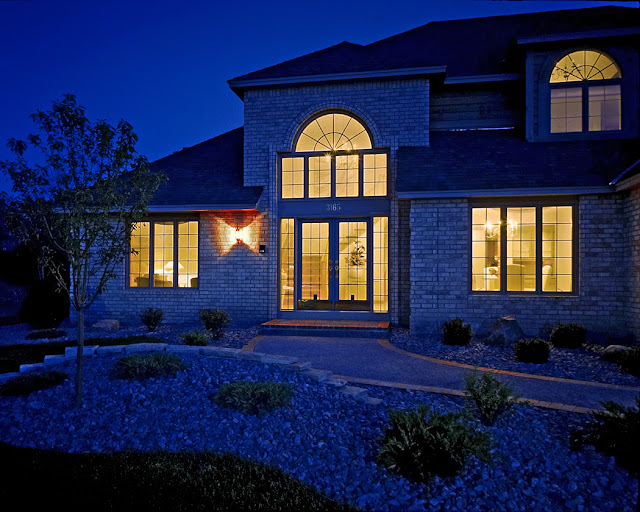
I decided to use tungsten film to accentuate the blue sky (a tungsten setting for the white light adjustment on a digital camera would do the same). A careful reading of the interior was used to determine the camera setting. This had to be taken via a reflected reading since no access to the interior was available. For that an area of average brightness was chosen. For an intensely blue sky exposures of neutral to +1 are necessary. At that time of day lighting changes very fast. To get the correct exposure, spot readings were taken of the sky right above the building. As soon as the sky density had reached the +1 level, exposures were taken in short intervals until the sky darkened to neutral. These changes take place so quickly that no Polaroid test exposure would have rendered usable exposure settings. Subsequently, none of this was done with the help of Polaroid film or the almost instant feedback of the viewing screen on a digital camera. But it does show how a good hand held light meter can be an invaluable tool for total exposure control. Yet there is more.
Many photographers use seamless paper to achieve different colored backgrounds, and at times this is indeed a good choice. However, colored gels can in a lot of cases do very much the same, again with absolute control. In general, a white background material will usually lead to relatively light, pastel colors since it does reflect a large amount of the ambient light in addition to the background lighting. Gray surfaces are helpful in this respect. If, however, really intense, pure colors are needed, this is best done with a flat black background material like black seamless. The same test, as described above for backgrounds from white to black, can be done here. Regardless of the color of the gel, the three stop over exposure will render white as a four stop underexposure will render black. Exposure changes in 1/3 stop increments will reveal the various color densities which can be achieved. This incidentally is repeatable with virtually absolute accuracy if the same gels and background materials are used.
Photography inevitably requires accurate exposure settings. The more control we are able to exercise over these exposure settings, the better the outcome of our photographs. Besides the camera, the most important tool here is the photographer, his or her knowledge about exposure control and the help of a good reflective/incident light meter.
For other articles on this blog please click on Blog Archive in the column to the right
To comment or to read comments please scroll past the ads below.
All ads present items of interest to Leica owners.
_________________________________________________________________________
For other articles on this blog please click on Blog Archive in the column to the right
To comment or to read comments please scroll past the ads below.
All ads present items of interest to Leica owners.
_________________________________________________________________________

Buy vintage Leica cameras from
America's premier Leica specialist

Buy vintage Leica cameras from
America's premier Leica specialist
Click on image to enlarge
Order: info@gmpphoto.com
Please make payment via PayPal to GMP Photography
Click on image to enlarge
Order: info@gmpphoto.com
Click on image to enlarge
Order: info@gmpphoto.com
Click on image to enlarge
Order: info@gmpphoto.com
Please make payment via PayPal to GMP Photography
Click on image to enlarge
Order: info@gmpphoto.com
Please make payment via PayPal to GMP Photography
Click on image to enlarge
Order: info@gmpphoto.com
Please make payment via PayPal to GMP Photography
























